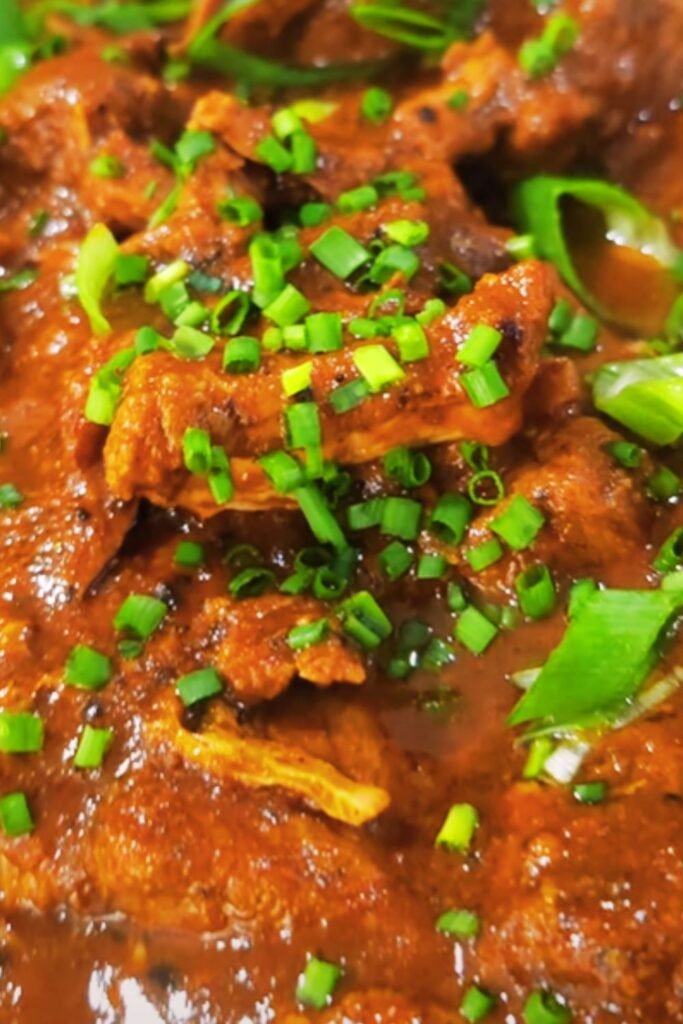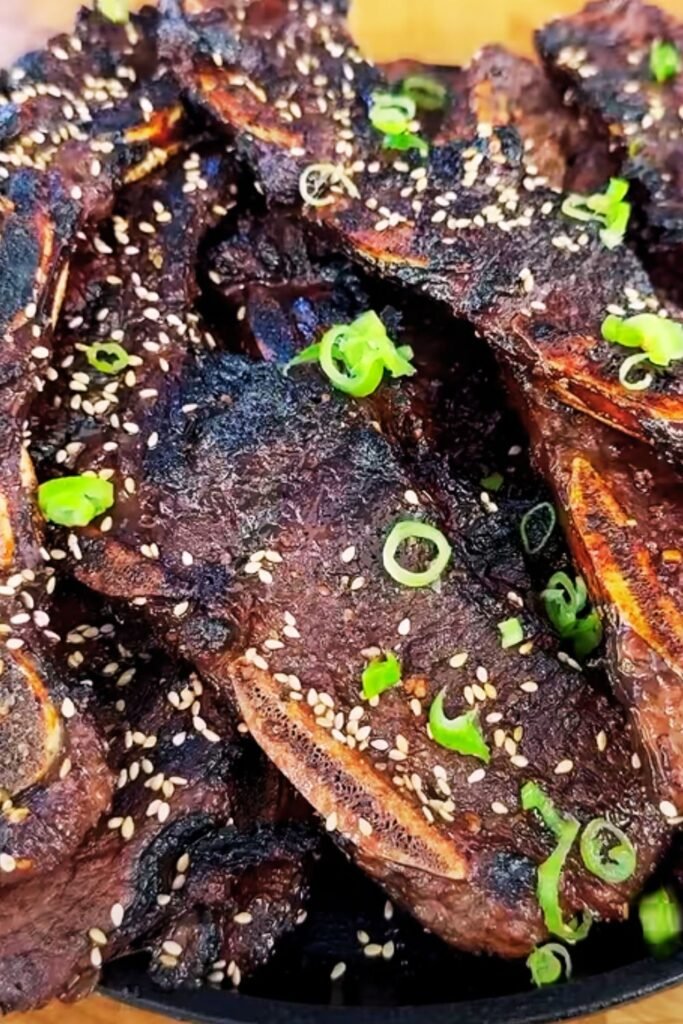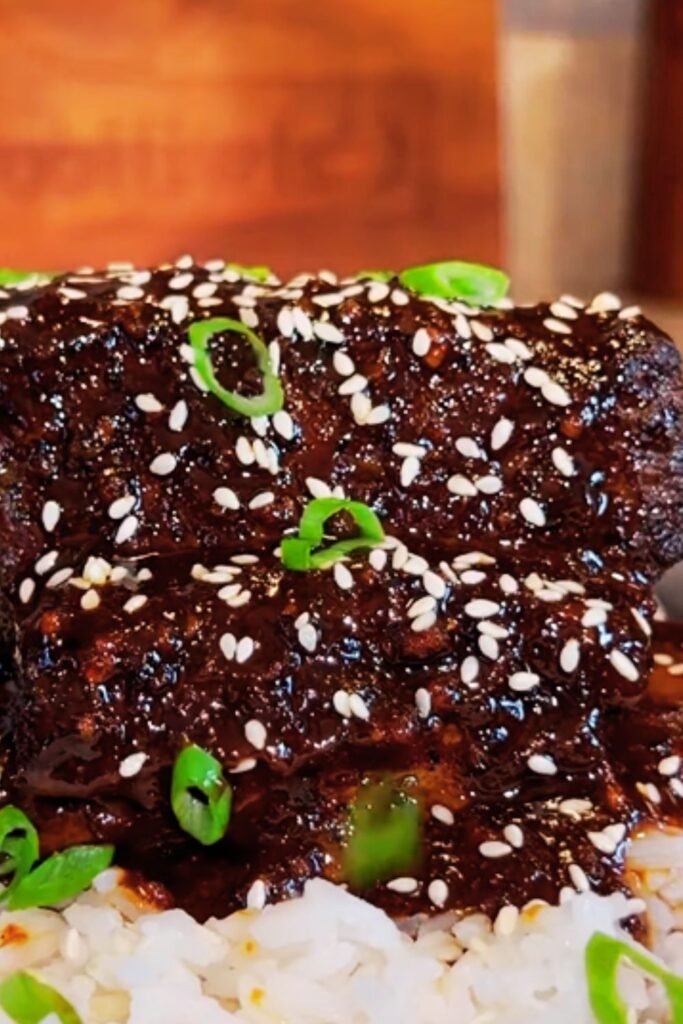There’s something magical about the moment when you lift the lid off a slow-cooked pot roast. The rush of aromatic steam, the tender meat practically falling apart, and that rich, developed flavor that only comes from hours of patient cooking. Now imagine infusing those comforting feelings with the bold, complex flavors of Korean cuisine. That’s exactly what I’m sharing with you today—a Korean Style Pot Roast that marries the best of both culinary worlds.
When I first experimented with this fusion dish, I was searching for something that would satisfy my craving for traditional comfort food while introducing some excitement to the dinner table. The result was nothing short of extraordinary. The familiar, tender texture of American pot roast combined with the umami-rich, sweet-spicy-savory balance that Korean cuisine is known for creates a dish that’s both nostalgic and novel.
In this article, I’ll walk you through every step of creating this showstopper meal, from selecting the right cut of beef to balancing the distinctive Korean flavors. Whether you’re cooking for a special occasion or simply want to elevate your weeknight dinner routine, this Korean Style Pot Roast is guaranteed to impress.
Understanding the Ingredients
Before we dive into the cooking process, let’s take a moment to understand the key ingredients that make this Korean Style Pot Roast special:
- Chuck Roast: The foundation of any good pot roast, this well-marbled cut breaks down beautifully during slow cooking.
- Gochujang: This fermented Korean chili paste brings a complex heat with subtle sweetness.
- Soy Sauce: Provides the umami foundation.
- Brown Sugar: Balances the heat and adds caramelization.
- Rice Wine Vinegar: Adds brightness and helps tenderize the meat.
- Sesame Oil: Contributes that distinctive nutty flavor.
- Asian Pear: A traditional Korean meat tenderizer that adds subtle sweetness.
- Ginger and Garlic: Aromatic foundations of Korean cooking.
- Korean Radish (Mu): Similar to daikon, this adds a refreshing crunch and absorbs the flavors of the broth.
Each ingredient plays a vital role in creating the complex flavor profile that makes this dish so special. Now, let’s get cooking!
Essential Equipment
Before starting, make sure you have these kitchen tools ready:
- Dutch Oven: A heavy-bottomed pot with a tight-fitting lid is ideal. Cast iron works wonderfully.
- Sharp Knife: For trimming the meat and slicing vegetables.
- Cutting Board: Preferably with a groove to catch juices.
- Measuring Cups and Spoons: For accurate ingredient proportions.
- Wooden Spoon: For scraping up those flavorful browned bits.
- Kitchen Twine: If you need to tie the roast.
- Meat Thermometer: To ensure perfect doneness.
Korean Style Pot Roast Recipe

Ingredients
For the Pot Roast:
- 4-5 pounds chuck roast, trimmed of excess fat
- 2 tablespoons vegetable oil
- 1 large onion, sliced into thick rings
- 6 cloves garlic, minced
- 2 tablespoons fresh ginger, grated
- 1 Asian pear, peeled and grated
- 1 cup beef broth
- 2 carrots, cut into 2-inch chunks
- 1 Korean radish (mu) or daikon, cut into 2-inch chunks
- 3 stalks celery, cut into 2-inch pieces
- 2 tablespoons sesame seeds, for garnish
- 4 green onions, sliced diagonally, for garnish
For the Korean-Inspired Marinade:
- 1/4 cup gochujang (Korean chili paste)
- 1/3 cup soy sauce (low sodium preferred)
- 3 tablespoons brown sugar
- 2 tablespoons rice wine vinegar
- 1 tablespoon sesame oil
- 1 tablespoon minced garlic
- 1 tablespoon grated ginger
- 1 teaspoon black pepper
Instructions
- Prepare the Marinade: In a mixing bowl, combine gochujang, soy sauce, brown sugar, rice wine vinegar, sesame oil, minced garlic, grated ginger, and black pepper. Whisk until thoroughly combined.
- Prepare the Meat: Pat the chuck roast dry with paper towels. Season generously with salt and pepper on all sides.
- Sear the Meat: Heat vegetable oil in a Dutch oven over medium-high heat. When the oil is shimmering, add the roast and sear on all sides until deeply browned, about 3-4 minutes per side. This step is crucial for developing flavor, so don’t rush it. Remove the meat and set aside.
- Build the Flavor Base: In the same pot, add the sliced onions. Cook for about 3-4 minutes, stirring occasionally, until they begin to soften. Add the minced garlic and grated ginger, cooking for another minute until fragrant. Pour in a small amount of beef broth and scrape up any browned bits from the bottom of the pot.
- Add the Marinade: Pour the Korean marinade into the pot and stir to combine with the onion mixture. Return the seared roast to the pot, spooning some of the sauce over the top.
- Add Remaining Ingredients: Pour in the remaining beef broth. The liquid should come about halfway up the sides of the roast. Add the grated Asian pear around the meat.
- Slow Cook: Cover the Dutch oven with a tight-fitting lid and reduce heat to low. Let the roast simmer gently for 3 hours, turning occasionally. After 3 hours, add the carrots, Korean radish, and celery around the meat. Continue cooking for another 1-1.5 hours, or until the meat is fork-tender and vegetables are soft.
- Rest and Serve: Remove the pot from heat and let the roast rest for 15-20 minutes before slicing. This allows the juices to redistribute throughout the meat.
- Finish the Dish: Transfer the meat to a cutting board and slice against the grain. Arrange the sliced meat on a serving platter with the cooked vegetables around it. Spoon the rich sauce over the meat and vegetables. Garnish with sliced green onions and a sprinkle of sesame seeds.
Common Mistakes to Avoid
When making this Korean Style Pot Roast, watch out for these pitfalls:
- Skipping the Sear: This crucial step develops deep flavor through the Maillard reaction.
- Cooking at Too High Temperature: Low and slow is the key to tender pot roast.
- Not Checking the Liquid Level: Make sure there’s always enough liquid in the pot.
- Slicing With the Grain: Always cut perpendicular to the visible muscle fibers for maximum tenderness.
- Rushing the Process: Good pot roast takes time; trying to speed it up will result in tough meat.
Variations to Try
The beauty of this fusion dish is how adaptable it is. Here are some variations I’ve experimented with:
Spice Level Adjustments
| Preference | Gochujang Amount | Additional Adjustments |
|---|---|---|
| Mild | 2 tablespoons | Add 1 tablespoon honey |
| Medium | 1/4 cup | Standard recipe |
| Spicy | 1/3 cup | Add 1 teaspoon Korean chili flakes (gochugaru) |
| Extra Hot | 1/2 cup | Add 1 tablespoon gochugaru and 1 sliced fresh chili |
Cooking Method Alternatives
| Method | Cooking Time | Special Instructions |
|---|---|---|
| Dutch Oven | 4-5 hours | 325°F oven or stovetop on low |
| Slow Cooker | 8-9 hours (low) | Sear meat separately first |
| Pressure Cooker | 60-75 minutes | Natural release for 15 minutes |
| Sous Vide | 24-36 hours | 131°F, finish with a sear |
Protein Alternatives
While traditional chuck roast is my go-to, I’ve had success with these alternatives:
- Brisket: Cook slightly longer, results in fantastic texture
- Short Ribs: Reduce cooking time by about 30 minutes
- Pork Shoulder: Excellent alternative with slightly sweeter flavor profile
- Beef Cheeks: My favorite for special occasions – incredibly tender

Serving Suggestions
A dish this flavorful deserves thoughtful accompaniments. Here are my favorite ways to serve Korean Style Pot Roast:
- Traditional Korean Sides: Serve with banchan (small side dishes) like kimchi, pickled daikon, or spinach namul.
- Over Rice: Steamed short-grain rice is perfect for soaking up the delicious sauce.
- In Lettuce Wraps: Offer butter lettuce leaves for wrapping slices of the pot roast with a smear of ssamjang (Korean dipping sauce).
- With Noodles: Serve over chewy Korean sweet potato noodles (japchae) for an interesting texture contrast.
- Family Style: Place the whole roast on a platter surrounded by roasted vegetables for a dramatic presentation.
For a complete meal, I recommend including:
- A bright salad with citrus dressing to cut through the richness
- Pickled vegetables for acidity
- Steamed rice or fresh bread to soak up the sauce
- A light, refreshing dessert like fresh fruit or sorbet
Make-Ahead and Storage Tips
This Korean Style Pot Roast actually improves with time, making it perfect for meal prep:
- Make Ahead: Cook the roast 1-2 days before serving. The flavors will deepen as it sits in the refrigerator.
- Refrigeration: Store in an airtight container for up to 4 days.
- Freezing: Freeze in portion-sized containers for up to 3 months. Thaw overnight in the refrigerator.
- Reheating: For best results, reheat slowly in a covered pot with a splash of beef broth to maintain moisture.
Troubleshooting Common Issues
| Problem | Possible Cause | Solution |
|---|---|---|
| Tough Meat | Undercooked or wrong cut | Cook longer or ensure you’re using a well-marbled cut |
| Too Salty | Too much soy sauce | Balance with a bit more brown sugar or dilute with beef broth |
| Too Spicy | Too much gochujang | Add more brown sugar or serve with cooling sides like cucumber |
| Dry Texture | Overcooked or lean cut | Choose fattier cut next time or add more liquid during cooking |
| Thin Sauce | Not enough reduction | Remove meat and simmer sauce until thickened, or add cornstarch slurry |
Nutritional Information
| Nutrient | Amount per Serving |
|---|---|
| Calories | 385 |
| Protein | 35g |
| Carbohydrates | 12g |
| Fat | 22g |
| Fiber | 2g |
| Sodium | 720mg |
| Serving Size | 6 oz meat with sauce and vegetables |
Note: Nutritional values are approximate and based on 8 servings per recipe.

The Cultural Fusion Behind the Recipe
I find the history behind fusion dishes absolutely fascinating. Korean cuisine dates back thousands of years, with an emphasis on fermented foods, balanced flavors, and communal eating. Traditional American pot roast, meanwhile, has European roots and became popular in the United States as an economical way to transform tough cuts of meat into delicious family meals.
This Korean Style Pot Roast honors both traditions. The low-and-slow cooking method respects the American pot roast tradition, while the bold flavors of gochujang, sesame, and ginger celebrate Korean culinary heritage. It’s a perfect example of how culinary traditions can complement each other, creating something that’s even more delicious than the sum of its parts.
What I particularly love about this fusion is how it introduces Korean flavors in an approachable way. For those who might be intimidated by traditional Korean dishes, this pot roast offers a familiar format with exciting new flavors.
Frequently Asked Questions
Q: Can I make this recipe less spicy while still maintaining the Korean flavor profile?
Yes, absolutely! The gochujang provides both heat and flavor, but you can reduce the amount to 2 tablespoons for a milder version. To maintain the depth of flavor, add 1 tablespoon of tomato paste and an extra tablespoon of brown sugar to compensate.
Q: Is there a substitute for Asian pear if I can’t find one?
Yes, you can substitute a regular Bosc pear or even a sweet apple like Fuji. The enzyme that helps tenderize meat is similar. In a pinch, you can also use 2 tablespoons of unsweetened applesauce mixed with 1 teaspoon of lemon juice.
Q: Can this recipe be made in a slow cooker?
Absolutely! Sear the meat as directed, then transfer everything to a slow cooker. Cook on low for 8-9 hours or on high for 4-5 hours. Add the vegetables during the last 2 hours of cooking time.
Q: What’s the best way to slice the pot roast?
For maximum tenderness, allow the meat to rest for at least 15 minutes after cooking, then slice against the grain. This means cutting perpendicular to the visible muscle fibers, which shortens them and makes each bite easier to chew.
Q: Can I use a different cut of beef?
Yes! While chuck roast is traditional for pot roast, you can also use brisket, round roast, or short ribs. Each will give slightly different results, but all work well with this cooking method. Just adjust cooking times accordingly – brisket may need an extra 30-45 minutes, while short ribs might cook a bit faster.
Q: How can I thicken the sauce if it’s too thin?
If you’d like a thicker sauce, remove the meat and vegetables after cooking. Bring the liquid to a simmer and reduce for 10-15 minutes, or whisk in a slurry made from 1 tablespoon cornstarch mixed with 2 tablespoons water. Simmer for another 2-3 minutes until thickened.
Q: What sides would complete this meal for a dinner party?
For an impressive dinner party spread, serve this pot roast with Korean mixed grain rice, quick cucumber kimchi, sautéed spinach with garlic, and a simple green salad with sesame dressing. The combination of textures and flavors will wow your guests.
Q: How can I make this dish more authentic to Korean cuisine?
To lean more toward traditional Korean flavors, add 2 tablespoons of doenjang (Korean fermented soybean paste), use Korean radish instead of carrots, and include dried shiitake mushrooms that have been rehydrated. You could also add perilla leaves (kkaennip) during the last few minutes of cooking.
Final Thoughts
There’s something deeply satisfying about creating a dish that bridges culinary traditions. This Korean Style Pot Roast represents the best of cross-cultural cooking—respecting the techniques and flavor profiles of both Korean and American cuisine while creating something uniquely delicious.
What I love most about this recipe is its versatility. It’s impressive enough for a dinner party but comforting enough for a family Sunday dinner. The leftovers transform beautifully into sandwiches, rice bowls, or even fillings for steamed buns.
Cooking should be an adventure, and this fusion pot roast is definitely one worth taking. The combination of tender, slow-cooked beef with the vibrant, complex flavors of Korean cuisine creates a memorable dish that will have everyone at your table asking for seconds.
I encourage you to make this recipe your own. Adjust the spice level, experiment with different vegetables, or try one of the alternate cooking methods. Whatever adaptations you make, keep the essence of what makes this dish special—the marriage of slow-cooked tenderness with bold Korean flavors.
Happy cooking, and enjoy your culinary fusion journey!